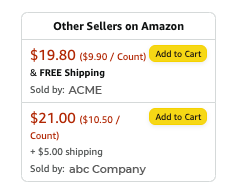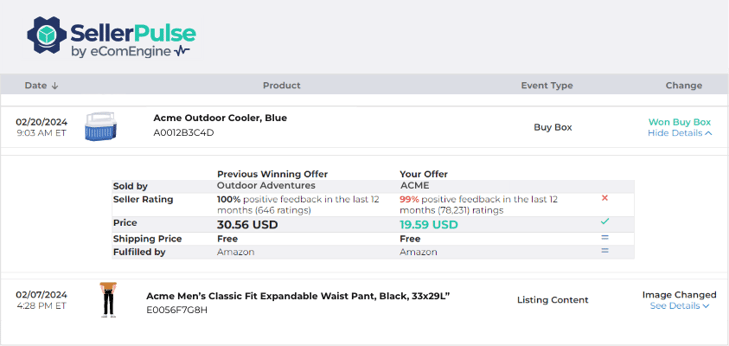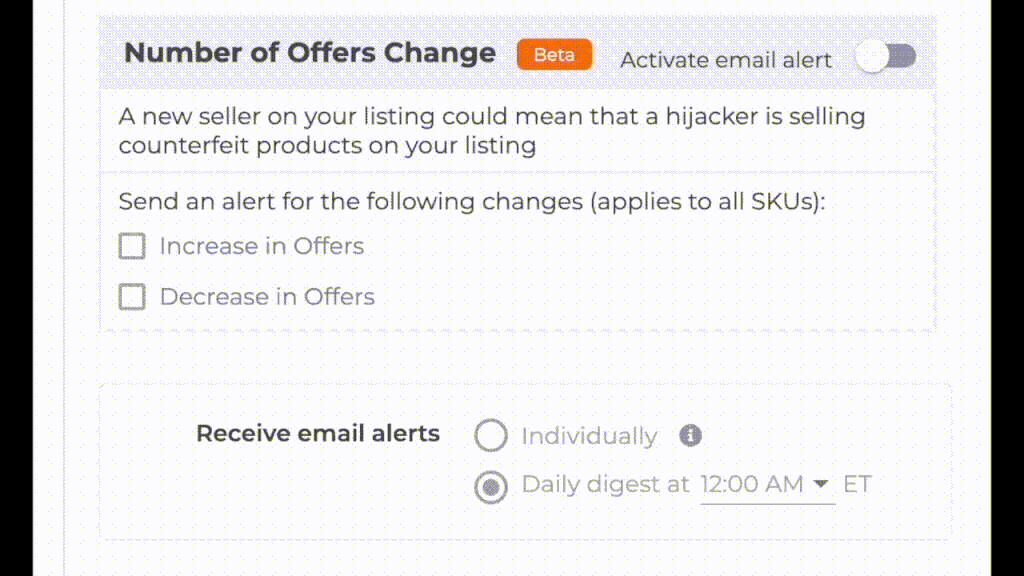Originally published on May 23, 2023, updated March 5, 2025
Menu
Join Our Email List
- Receive our monthly newsletter.
- Stay up to date on Amazon policies.
- Get tips to grow your business.
You’re careful to follow all of Amazon’s rules. You’ve managed to build a strong reputation on the platform, and won’t do anything to put that at risk. But not everyone selling on Amazon has your integrity. And unfortunately, some of the sleazier actors on the platform have found creative ways to piggyback on the success of others.
For Amazon sellers that play by the rules, learning that a scammer is taking advantage of your hard work to win sales is like a slap in the face. To protect yourself, you need to be on the lookout for signs of Amazon hijacking.
You must stay vigilant as Amazon hijacking can come in various forms that demand your attention.
Listing imitation is what occurs when a seller duplicates your listing, making only slight changes. They might tweak the product name by a couple of characters or alter the photos slightly.
The goal is to undercut your high-performing listing and capture the Buy Box. Not only does it have the potential to damage your sales, but it can also harm your credibility with your customer base. Listing imitation can impact brands and resellers alike.
 Counterfeit products are made to look similar to items sold by well-respected brands. Nefarious sellers aim to fool potential buyers into thinking they’re getting a great deal on a high-quality private-label item, only to receive a cheap imitation instead.
Counterfeit products are made to look similar to items sold by well-respected brands. Nefarious sellers aim to fool potential buyers into thinking they’re getting a great deal on a high-quality private-label item, only to receive a cheap imitation instead.
Counterfeit products are nothing new, but the internet makes the con easier for perpetrators who can use photos of the real thing so customers won’t recognize the difference until it's too late. (And that's if they recognize it at all.) Some buyers will assume they received a legitimate product, and their disappointment will be reflected in your product reviews.
Account hijacking is when someone hacks into a brand or reseller’s account and takes it over. Once they’re in, they can change your listings in any way that they want.
Often, Amazon account hijackers resort to altering prices and descriptions to make your listings seem less appealing. This sneaky tactic can give them an unfair advantage by drawing more customers to their own products. Even worse, they may even be able to succeed in getting you suspended.
 Listing saboteurs poison a competitor’s listing by price gauging and leaving fake negative reviews. They create fake buyer accounts and test buy your products to seem convincing, but then turn around and leave terrible reviews. In doing so, they can damage your reputation and cause a significant drop in sales.
Listing saboteurs poison a competitor’s listing by price gauging and leaving fake negative reviews. They create fake buyer accounts and test buy your products to seem convincing, but then turn around and leave terrible reviews. In doing so, they can damage your reputation and cause a significant drop in sales.
Some of the bad actors who practice other forms of ASIN hijacking will also use threats of listing sabotage to dissuade victimized sellers from taking action. Brands that have worked hard to earn reviews the right way may be hesitant to go after imitators and counterfeiters if it puts their star rating at risk.
 ASIN piggybacking is a tactic used by other sellers typically looking to cash in on your product's success. They list the same product under the same ASIN at a lower price, luring customers away from your listing. Unlike traditional reselling, piggybacking often involves selling cheap knockoffs to contend with their lower price tag. It's important to keep an eye on the "Other Sellers on Amazon" box on your listing to identify piggybackers, but don't jump to conclusions as it could also be a legitimate reseller. Regardless, it's always wise to investigate further.
ASIN piggybacking is a tactic used by other sellers typically looking to cash in on your product's success. They list the same product under the same ASIN at a lower price, luring customers away from your listing. Unlike traditional reselling, piggybacking often involves selling cheap knockoffs to contend with their lower price tag. It's important to keep an eye on the "Other Sellers on Amazon" box on your listing to identify piggybackers, but don't jump to conclusions as it could also be a legitimate reseller. Regardless, it's always wise to investigate further.
Keep reading: Amazon Listing Hijacking: What It Is and What to Do About It
Amazon hijackers have the power to do a lot of damage to brands and resellers on the platform. Hijackers offering better prices can claim the Buy Box, leading to revenue loss, damaged brand reputation, and a drop in Best Seller ranking. There is also a risk of suspension as Amazon may mistake their actions for yours.
Amazon hijacking creates a bad experience for everyone involved. It hurts your business. It leaves customers disappointed. And it’s bad for Amazon’s reputation. When it happens, you want to respond fast.
But for that to happen, you have to know about it in the first place. While there are several ways that you can help protect your products from hijackers, the most effective way to fight them off is to monitor your listings regularly.
Here are some things to look out for that may signal your listing has been compromised:
Learn about changes to your product listings faster with SellerPulse.

Sign up today to be notified when:

Amazon wants customers to have a good buying experience, so it will work with you to root out the bad actors once it knows about them.
If you suspect a hijacker, it's wise to make a test purchase and thoroughly examine the product. Then, send a cease and desist letter and/or report the hijacker to Amazon using photos and notes to make a case for the counterfeit product's negative impact on customers. Amazon should investigate and hopefully remove the hijacker from your listing. With a quick enough response, you may be able to avoid catastrophic damage to your brand and bottom line.
Learn more about SellerPulse's product alerts by watching the short video below!
Originally published on May 23, 2023, updated March 5, 2025
This post is accurate as of the date of publication. Some features and information may have changed due to product updates or Amazon policy changes.
These Stories on Alerts
14321 Winter Breeze Drive
Suite 121 Midlothian, VA 23113
Call us: 800-757-6840





Copyright© 2007-2025 eComEngine, LLC. All Rights Reserved. eComEngine®, FeedbackFive®, RestockPro®, and SellerPulse® are trademarks or registered trademarks of eComEngine, LLC. Amazon's trademark is used under license from Amazon.com, Inc. or its affiliates.
No Comments Yet
Let us know what you think